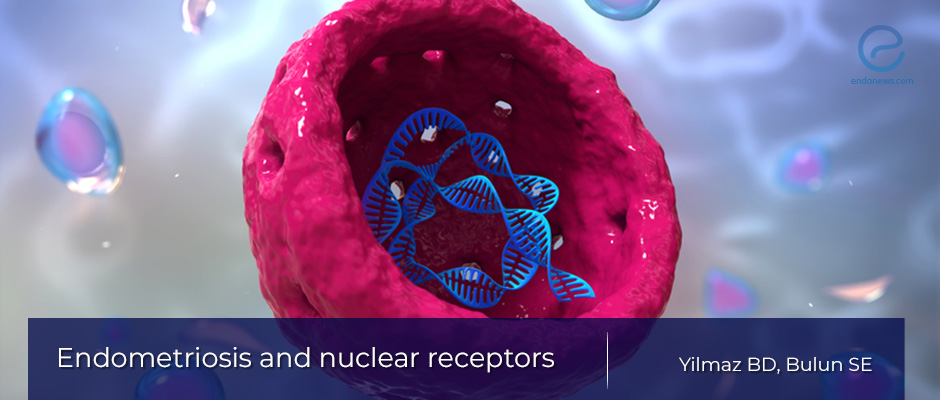Endometriosis and nuclear receptors
May 1, 2019
The role of nuclear receptors in endometriosis progression
Key Points
Highlight:
- New synthetic ligands, targeting progesterone receptor, retinoic acid receptors and estrogen receptor beta, may offer novel treatment options.
Background:
- It is well recognized that endometriosis is a steroid-dependent disorder.
- In endometrial stromal cells, progesterone regulates retinoic acid production and action.
- Retinoids also act via a number of nuclear receptors (NRs) and are involved in normal endometrial function and endometriosis.
- Estrogen receptors alpha and beta (ESR1 and ESR2) and progesterone receptor (PGR) are the key steroid receptors involved in the pathophysiology of endometriosis.
- However, the precise roles of NRs in steroid responsiveness and other signaling pathways are not well understood.
- Here, Dr. Bulun group from Northwestern University review and clarify new information regarding the mechanisms of NRs in endometriosis and emphasize the roles of the relevant nuclear receptors for this pathological condition.
Key points:
- There are four distinct abnormalities in the intracavitary endometrium and extra-uterine endometriotic tissue underlie endometriosis progression.
- Dysregulated differentiation of endometrial mesenchymal cells, abnormal epigenetic marks, inflammation activated by excess estrogen and the development of progesterone resistance.
- Endometriotic stromal cells compose the bulk of the lesions and demonstrate widespread epigenetic abnormalities. They also display a wide range of abnormal NR expression.
- The dominance of NR5A1, an orphan NR, in endometriotic stromal cells gives rise to excessive estrogen formation.
- Endometriotic stromal cells also show an excessive level of ESR2, which mediates an estrogen-driven inflammatory process and prostaglandin formation.
- These cells are also deficient in PGR, leading to progesterone resistance and defective retinoid synthesis. And the pattern of NR expression, involving low ESR1 and PGR and high ESR2, is reminiscent of uterine leiomyoma stem cells.
- Based on this finding, Dr. Bulun group speculate that endometriotic stromal cells may display stem cell characteristics found in other uterine tissues.
Conclusion and Implications:
- Steroid- and other NR-related abnormalities exert genome-wide biologic effects via interaction with defective epigenetic programming and enhance inflammation in endometriotic stromal cells.
- New synthetic ligands, targeting PGR, retinoic acid receptors, and ESR2, may offer novel treatment options in the future.
Lay Summary
It is well recognized that endometriosis is a steroid-dependent disorder. In endometrial stromal cells, progesterone regulates retinoic acid production and action. Retinoids also act via a number of nuclear receptors (NRs) and are involved in normal endometrial function and endometriosis. Estrogen receptors alpha and beta (ESR1 and ESR2) and progesterone receptor (PGR) are the key steroid receptors involved in the pathophysiology of endometriosis. However, the precise roles of NRs in steroid responsiveness and other signaling pathways are not well understood.
Here, Dr. Bulun group from Northwestern University review and clarify new information regarding the mechanisms of NRs in endometriosis.
Four distinct abnormalities in the intracavitary endometrium and extra-uterine endometriotic tissue underlie endometriosis progression: dysregulated differentiation of endometrial mesenchymal cells, abnormal epigenetic marks, inflammation activated by excess estrogen and the development of progesterone resistance.
Endometriotic stromal cells compose the bulk of the lesions and demonstrate widespread epigenetic abnormalities. They also display a wide range of abnormal NR expression. The dominance of NR5A1, an orphan NR, in endometriotic stromal cells gives rise to excessive estrogen formation. Endometriotic stromal cells also show an abnormally low ESR1:ESR2 ratio due to excessive levels of ESR2, which mediates an estrogen-driven inflammatory process and prostaglandin formation. These cells are also deficient in PGR, leading to progesterone resistance and defective retinoid synthesis. The pattern of NR expression, involving low ESR1 and PGR and high ESR2, is reminiscent of uterine leiomyoma stem cells. Based on this finding, Dr. Bulun group speculate that endometriotic stromal cells may display stem cell characteristics found in other uterine tissues.
In conclusion, steroid- and other NR-related abnormalities exert genome-wide biologic effects via interaction with defective epigenetic programming and enhance inflammation in endometriotic stromal cells. Dr. Bulun group believe that new synthetic ligands, targeting PGR, retinoic acid receptors, and ESR2, may offer novel treatment options in the future.
Research Source: https://www.ncbi.nlm.nih.gov/pubmed/30809650
Endometriosis Nuclear receptors Stem cells SF-1 ESR2 NR2F2 PGR Progesterone resistance Retinoids

